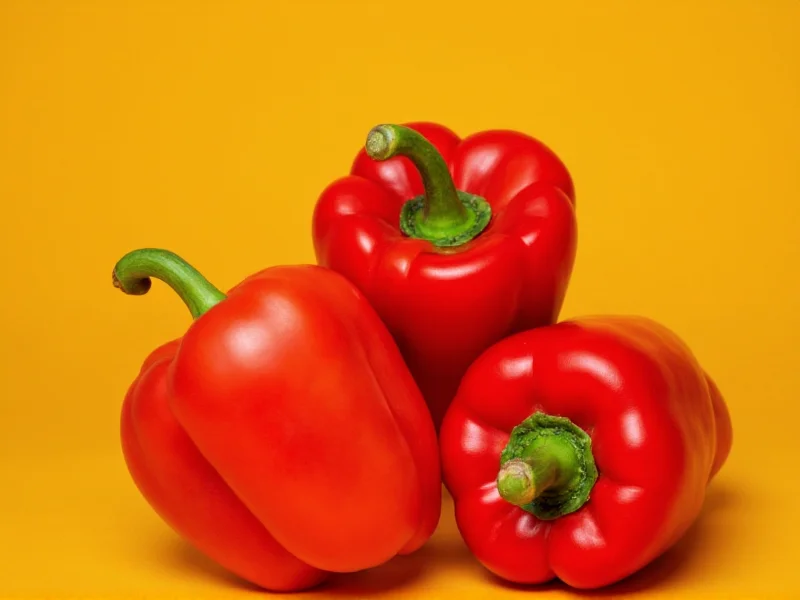Bell peppers and sweet peppers are the same vegetable—there is no botanical or culinary difference between them. The terms are used interchangeably, with “bell peppers” describing their distinctive bell-like shape and “sweet peppers” emphasizing their lack of heat compared to chili peppers. This confusion stems from regional naming preferences rather than any actual distinction in the produce itself.
Understanding the terminology around peppers can prevent grocery store confusion and recipe mishaps. Many home cooks wonder if they need to seek out separate varieties when a recipe calls for “sweet peppers” versus “bell peppers.” The reality is simple: all standard bell peppers found in supermarkets are sweet peppers. They belong to the Capsicum annuum species and contain zero capsaicin—the compound that makes other peppers hot.
Why Two Names for the Same Pepper?
The dual terminology exists primarily for clarification. In botanical terms, “bell pepper” refers specifically to the blocky, four-lobed shape of this pepper variety. “Sweet pepper” serves as a broader category distinguishing non-pungent peppers from their spicy relatives. However, in everyday usage across North America and Europe, these terms have become synonymous.
Regional differences contribute to the naming confusion:
| Region | Common Terminology | Reason for Usage |
|---|---|---|
| United States | “Bell peppers” predominantly used | Shape-based naming convention |
| United Kingdom | “Sweet peppers” more common | Distinguishes from “hot peppers” |
| Australia/New Zealand | Mix of both terms | British influence with American media exposure |
| Canada | Both terms used interchangeably | Regional variation within country |
Botanical Classification Explained
All bell peppers fall under the species Capsicum annuum, which includes both sweet and hot varieties. The key difference lies in a single recessive gene that prevents capsaicin production in sweet varieties. This genetic trait makes bell peppers safe for those sensitive to spice while providing the same nutritional benefits as their fiery cousins.
Unlike chili peppers that evolved capsaicin to deter mammals, bell peppers developed their sweet profile through selective breeding. Farmers cultivated these non-pungent varieties specifically for culinary versatility. The complete absence of capsaicin places them in the sweet pepper category, though not all sweet peppers have the classic bell shape.
Color Varieties and Flavor Profiles
While shape and heat level define the bell/sweet pepper category, color indicates ripeness and affects flavor:
| Color Stage | Harvest Time | Sweetness Level | Best Culinary Uses |
|---|---|---|---|
| Green | Earliest harvest (unripe) | Least sweet, slightly bitter | Stir-fries, stuffed peppers, raw in salads |
| Yellow | Partially ripe | Moderately sweet | Roasting, grilling, fajitas |
| Orange | More ripe | Sweeter than yellow | Raw applications, blending into sauces |
| Red | Full ripeness | Most sweet, complex flavor | Raw consumption, salads, sauces, drying |
As bell peppers mature on the plant, their chlorophyll breaks down and carotenoids develop, creating the color progression from green to red. This ripening process increases sugar content by up to 30%, explaining why red bell peppers cost more—they require additional growing time.
Common Misconceptions Clarified
Several myths persist about bell peppers and sweet peppers:
- “Sweet peppers include other shapes:” While technically true botanically, in commercial contexts “sweet peppers” almost always means bell peppers. Other sweet varieties like banana peppers have distinct names.
- “Red bell peppers are a different species:” All colors come from the same plant—they're simply harvested at different maturity stages.
- “Bell peppers can become hot:” Without the dominant capsaicin-producing gene, bell peppers will never develop heat, regardless of growing conditions.
Culinary Applications and Substitutions
The interchangeable nature of bell and sweet peppers means recipes using either term require the same ingredient. When substituting:
- Use any color bell pepper when a recipe specifies “sweet pepper” or “bell pepper”
- Consider color's flavor impact—green for sharper notes, red for sweetness
- Never substitute hot peppers unless specifically desired (e.g., pimento peppers work in some applications)
For optimal freshness, store unwashed bell peppers in the crisper drawer for 1-2 weeks. Cooked peppers maintain quality for 3-5 days refrigerated. Freezing raw bell peppers preserves them for 6-8 months, though texture changes make them better suited for cooked dishes after thawing.
FAQ Section
Are all bell peppers considered sweet peppers?
Yes, all standard bell peppers are sweet peppers. The term “sweet” distinguishes them from hot chili peppers, but in commercial contexts, these terms refer to the exact same vegetable with the characteristic bell shape.
Why do some recipes specify “sweet peppers” instead of bell peppers?
Recipes may use “sweet peppers” to emphasize the non-spicy nature of the ingredient, particularly in regions where “bell peppers” isn't the common term. It also prevents confusion with spicy pepper varieties that might share “pepper” in their name.
Do bell peppers get sweeter as they change color?
Yes, bell peppers become significantly sweeter as they mature from green to yellow, orange, and finally red. The red varieties contain nearly twice the beta-carotene and 10-15% more vitamin C than their green counterparts due to extended ripening time on the plant.
Can bell peppers ever be spicy?
No, true bell peppers cannot be spicy. They lack the genetic makeup to produce capsaicin, the compound responsible for heat in peppers. Any “hot” bell pepper would actually be a different variety mislabeled or cross-pollinated with a hot pepper variety.
What's the difference between sweet bell peppers and banana peppers?
While both are sweet peppers, banana peppers have a elongated shape resembling bananas and typically milder, tangier flavor. True bell peppers have the distinctive blocky, four-lobed shape. Some banana pepper varieties can develop slight heat as they mature, unlike consistent sweetness in bell peppers.











 浙公网安备
33010002000092号
浙公网安备
33010002000092号 浙B2-20120091-4
浙B2-20120091-4